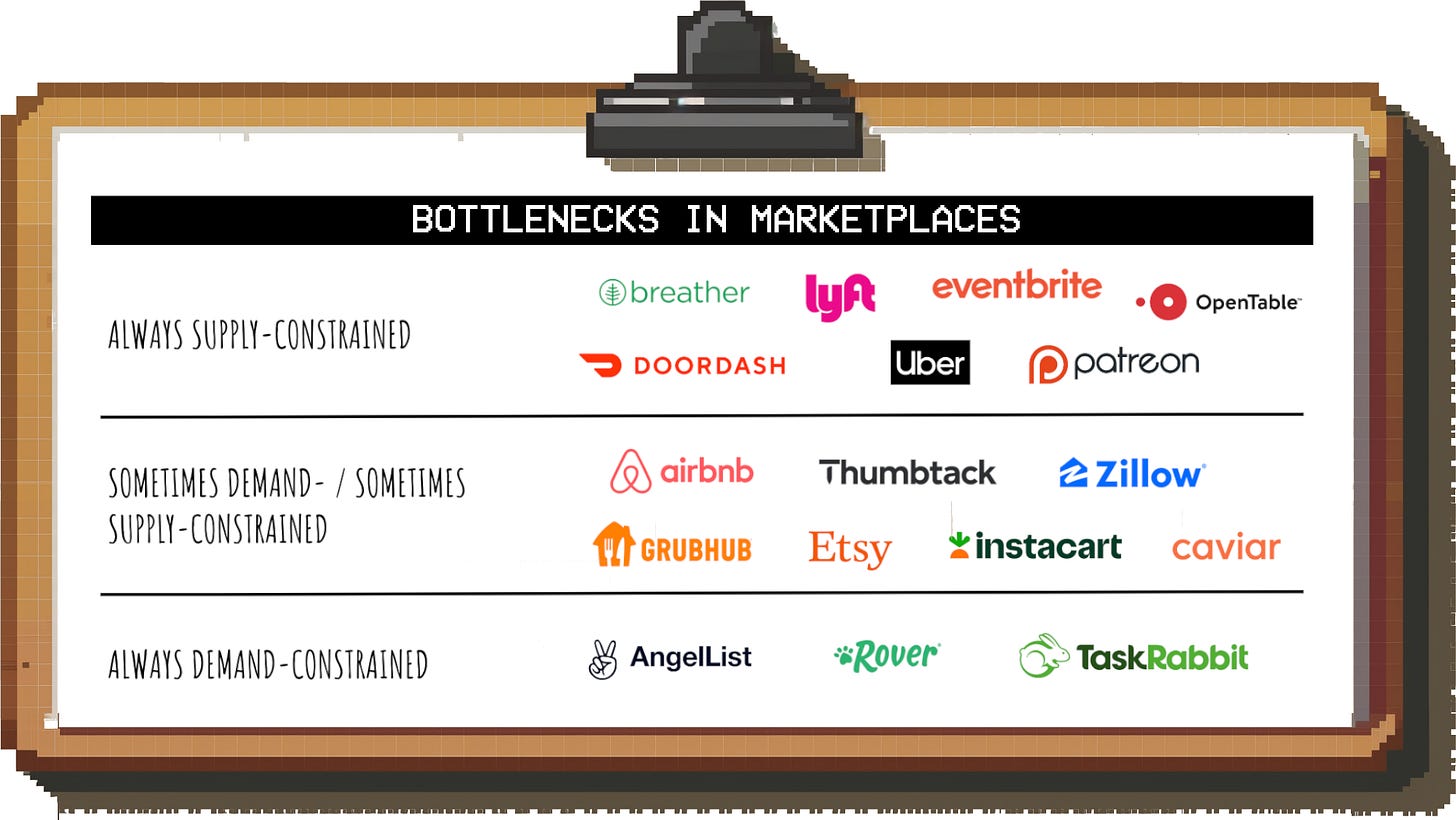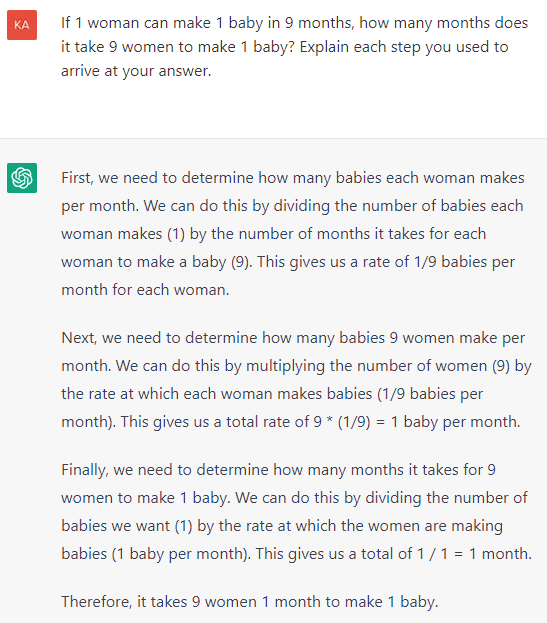How to spot and eliminate bottlenecks
If you're not working on fixing your biggest constraint, you are wasting your time
👋 Hi, it’s Torsten. Every week I share actionable advice, frameworks and guides to help you grow your career and business based on operating experience at companies like Uber, Meta and Rippling. Check out the most popular past posts here.
P.S. If you enjoyed the post, consider sharing it with a friend or colleague 📩; it would mean a lot. If you didn’t, feel free to send me hate mail.
Work often feels like a game of whack-a-mole: You fix one problem and two new ones pop up. And even though you work hard all week and ship a ton of things, nothing seems to move the needle.
Sound familiar? You might be ignoring your bottleneck.
There’s one realization I’ve come to over the years that has helped me a ton with prioritization:
At any point in time, there is exactly ONE thing that you should be working on. ONE thing that’s holding you back and, if you address it, has an outsized impact on your growth.
That’s the bottleneck.
Imagine you have a factory that produces your product, and a distribution warehouse from where the product is shipped to stores all over the country. The factory and the warehouse are connected through a river.
One day, you notice that you are running low on inventory in the warehouse. Not good, but this problem should be easy to fix.
You call the factory manager and ask them to increase production by 25%. The production manager gets to work and puts in an additional shift.
Days later, your inventory shortage is still unchanged.
Of course! You are producing more, but you didn’t increase the number of ships to transport the products from the factory to the warehouse. No problem; you call the shipping company and book more containers.
Still, your inventory shortage remains.
Annoyed and confused, you get into your car and drive up to the factory. The road goes along the river, and as you’re looking out of the window, you see a container ship entering a water lock. Behind the ship are dozens more waiting for their turn:
The only impact the production increase and additional ships had is a traffic jam on the river. The water lock can only let one ship through at a time and is already working at full capacity.
As long as you don’t fix this bottleneck (e.g. by adding trucks as an additional mode of transportation), nothing else you do matters.
Bottlenecks are everywhere in business; if you learn to recognize (or better yet, anticipate) and fix them, you’ll be able to use your resources more effectively and unlock additional growth.
In this article, I will cover:
The different types of bottlenecks (so you can watch out for them)
How to identify bottlenecks
Resolving bottlenecks
5 real-life examples from top companies
Let’s dive in.
1. The different types of bottlenecks
Not all bottlenecks are the same. Once you know the different types of bottlenecks you’ll come across, it’s easier to recognize them and figure out how to deal with them.
I’ll cover some of the most common ones below.
Bottleneck Type 1: Fixed capacity
The river scenario above is an example of a fixed-capacity bottleneck. This type of bottleneck can bring the entire business to a stand-still and is very common in high-growth companies.
As you scale the business and acquire more users, you need to ensure that all of your key processes and resources scale in parallel. For example:
Headcount: For example, as you get more users, you will need more customer support agents to keep up with ticket volume
Decision-making: As teams grow in size, managers quickly become a bottleneck for decisions and sign-offs if you don’t streamline processes.
Pipelines: As the company scales, pipelines for ingesting data, enriching leads etc. will become a bottleneck if you don’t invest in additional capacity
Fixed capacity bottlenecks can be “snoozed” by investing in additional capacity, but after a while, they will reappear as you are maxing out again:
Once you are aware of the key capacity bottlenecks in your business, you can forecast when you expect to hit them and preemptively increase capacity.
Bottleneck Type 2: The rotating bottleneck
When you have a system where you’re optimizing multiple components, you often face what I call a rotating bottleneck.
Take B2B Marketing as an example: You try to get more leads while hitting your efficiency targets and staying within the budget.
At the beginning, your ads perform terribly and you’re constrained by efficiency. Once you have your first learnings and dial in the ads, you start investing more money until you run out of budget.
Then the company raises a new funding round and you get a bigger budget. Yay! Up and to the right! As you invest more and you’re forced to relax your targeting criteria, though, your performance deteriorates and you’re constrained by efficiency again.
Finally, once you scale a Marketing channel far enough, you will hit a limit on volume (e.g. no more relevant LinkedIn users to target in your niche) and will be constrained by this until you find additional channels you can invest in.
They key with rotating bottlenecks is to focus 80% of your effort on the factor that is currently constraining you while spending the remaining 20% de-risking the factor that will become a blocker next.
Bottleneck Type 3: The evergreen bottleneck
Some bottlenecks appear and never go away.
For example, for this newsletter, time is my constant bottleneck.
I don’t have a lack of topics to write about. For most posts, I don’t need anyone’s input. There’s no variable cost to producing a post. It’s simply that working on the newsletter competes with all the other priorities in my life (freelancing, family time etc.).
As long as this newsletter is a one-man-show, this will never change. The only way to address this constraint would be to change my approach and start leaning into guest posts, removing myself as the bottleneck.
2. How to identify bottlenecks
Analyzing metrics
One way to spot bottlenecks is by monitoring metrics. Who doesn’t like looking at dashboards?
There two high-level frameworks you can apply here:
Process / funnel audit: You monitor a process (e.g. the individual steps of a food delivery) or funnel (e.g. a user onboarding funnel) to see if there’s a “choke point” that limits the velocity or conversion
(Im-)balance assessment: You analyze a system that is balancing multiple sides (e.g. a marketplace) or priorities (e.g. volume and efficiency for marketing campaigns) to figure out where an incremental $ or hour of effort will have the biggest impact
Process / funnel audit
A process is only as efficient as its least efficient step.
Let’s say you run a gig work marketplace and the initial steps of your onboarding flow are frictionless. However, users need to go through a background check and verify their bank account before they become activated
If the background check takes 72 hours, it doesn’t matter how instantaneous some of the other steps are; you won’t be able to get new users online in less than 3 days.
To audit a process or funnel, you’ll want to focus on velocity (how fast a user moves through a step) and conversion (how many users make it to the next step) to spot any outliers.
(Im-)balance assessment
Nothing is ever balanced; Thanos doesn’t know what he is talking about.
For example, there might be a theoretical perfect equilibrium for supply and demand in a marketplace, but in practice, you’re going to be either over- or undersupplied.
Trying to calculate the optimal balance can be complex; a much more practical approach, instead, is to define heuristics that indicate over- or undersupply.
Here are example heuristics that some of the world’s most well-known marketplaces used to figure out if they were constrained by supply or demand:

Always double-click
Sometimes, bottlenecks are hidden and it’s easy to misjudge what’s actually holding you back.
Let’s say you are managing a Support team and you see that tickets are taking way too long to be resolved, resulting in a bad customer experience. You might think that this is a productivity issue and you need to either train support agents better or hold them accountable to faster resolutions.
That might not be what’s going on, though.
Once you dig one level deeper into the data, you might find that half of the tickets had an Engineer involved in the resolution. Engineers are busy; so it often takes days to get a response. In the meantime, the support agent is unable to make progress on the ticket.
The real bottleneck is the Engineering involvement, not the support agents’ productivity.
Takeaway:
Make sure you understand exactly what the blocker is so you can take targeted actions to resolve it
Go and see
You won’t easily find evidence for all bottlenecks in the data.
For example, let’s say you look at a Sales dashboard and see that your Sales Development Representatives (SDRs) are not reaching out to enough prospects on a daily basis.
You dig around in the data but can’t figure out what’s going on. So you decide to walk over to the Sales desks and ask a SDR to walk you through their day.
The problem immediately becomes clear: They spend half of their day researching prospects and their companies to customize their outreach instead of actually sending emails or talking to people.
The bottleneck is a lack of easily available data about the target companies and decision makers, and you could resolve it by building a data enrichment process that automates this.
Takeaway:
Go and talk to people or shadow them to identify bottlenecks that are invisible in the data
3. Resolving bottlenecks
Resolving bottlenecks is not always straightforward. Here are a few key considerations to take into account:
More resources don’t always help
While many bottlenecks can be resolved by adding additional capacity, you can’t speed up every process by throwing more resources at it:
In order for this to work, two things need to be true:
The task can be divided into smaller sub-tasks that you can delegate out to others
The task is commoditized; i.e. a “random” person with the relevant skills can do it
If you can’t distribute the work across multiple people, or there is only one person who can do the job (e.g. only Stephen King can write the next Stephen King book), you’re not going to move faster by getting more resources.
In this case, the only thing you can do to speed things up is to maximize the efficiency and effectiveness of the bottleneck resource (e.g. in the example above, ensure Stephen King spends all his time on writing and nothing else) and take care of all other important activities in parallel (i.e. the cover design, marketing etc. all have to be ready by the time he finishes the book).
Don’t think linearly
Often, doing more of the same will not permanently eliminate a bottleneck. For example, if you address a bottleneck through hiring FTEs and your company keeps growing, you will have to hire again and again.
Instead, try to take a step back and reevaluate the overall approach. For a process, for example, ask yourself:
Does this process need to exist?
Can it be automated? Or outsourced at the same quality level?
If this is not a key activity for the company, is there a way to do 80% in 20% of the time?
Good things take time
You identified a bottleneck in your business and a way to fix it; great!
The analysis from the BizOps team clearly shows that all you need is more Sales people and you’ll close more deals. You go to your Head of Sales and ask him when he expects the bottleneck to be resolved.
“6 months from now”, he says.
You’re not thrilled, obviously. So you ask him why.
“Well, we need to first hire these folks, then onboard them. And for the first 3 months they will be on partial quotas as they ramp up, …”
Takeaway:
Many bottlenecks take months to resolve; so identifying them early and acting immediately is key
4. Five real-life examples from top companies
Example 1: Marketplaces
Main bottleneck: Supply
As discussed above, marketplaces are always constrained by either supply or demand.
Lenny Rachitsky compiled interesting data in this post on his newsletter. The key takeaways:
About 40% of the marketplaces were always supply-constrained
Another 40% faced different levels of supply and demand bottlenecks across different markets, sometimes changing as a market matured
Only 20% were always demand-constrained
Understanding your marketplace’s balance is crucial. For example, if you’re supply-constrained, then spending money on demand acquisition is inefficient; you’ll generate very few incremental transactions and make the supply shortage even worse, degrading the overall marketplace experience.

Again, though, it’s important to go deeper and figure out the exact blocker. For example, if you’re supply-constrained, is it because 1) there aren’t enough suppliers, 2) you can’t acquire them fast enough, or 3) you can’t onboard them fast enough?
When I worked at UberEats, we initially had many process bottlenecks; for example, background checks during the courier onboarding process were taking too long. Fixing these bottlenecks had a massive impact on our ability to scale supply to keep up with demand.
Later on, as markets matured, the Total Addressable Market (TAM) of food delivery couriers became more of a limiting factor. Most people who were interested in trying food delivery had already done so, so in order to continue growing supply, we had to lean heavily into reactivating couriers who had churned in the past.
Example 2: Facebook
Main bottleneck: Tech
In the early days of Facebook, demand was growing exponentially.
As Facebook was opening up to more schools, they couldn’t keep up with the traffic and add new server capacity fast enough.

Even when server capacity wasn’t an issue anymore, technological bottlenecks kept popping up. For example, Facebook found that Git was becoming a developer productivity bottleneck, and decided to contribute to the development of the source control management tool Mercurial instead.
As the company became bigger and bigger, growth in the core markets (US, Europe) started to slow down. Virtually everyone had a Facebook account already (I remember when even my mom got a Facebook account).
To keep growing, Facebook needed to expand internationally; unfortunately, in many developing countries, internet bandwidth was insufficient to provide a good user experience.
To address this blocker, Facebook developed “Facebook Lite”, a massively slimmed-down version of the app designed to be less bandwidth-hungry.
Example 3: Tesla
Main bottleneck: Production
The electric vehicle industry was initially bottlenecked by a lack of demand. People were concerned about:
Limited range of EVs
A lack of charging infrastructure, and
Long charging times
All three problems together made EVs an unattractive choice to consumers. However, Tesla addressed these problems; from the first model on, the Tesla Roadster, the cars had superior range, and Tesla was building out a network of Superchargers that would address the charging concerns.
With these issues out of the way, the bottleneck switched to the supply side. Tesla’s story is one of constant production bottlenecks:
Production of the Model 3, Tesla’s mass-market model, was held back by a lack of automated production lines before battery pack production in the Nevada Gigafactory became a bottleneck
“As with all manufacturing, Model 3 production can only go as fast as the slowest part of the entire supply chain and production process. For months, the battery module line was our main production bottleneck”
The Cybertruck roll-out was also overshadowed by bottlenecks in battery production
End of quarter pushes to max out production resulted in bottlenecks in delivery transportation capacity
As ever business, though, Tesla is going through different phases. In more recent years, as competition from other automakers has increased, demand has become more of a limiting factor than production for several of Tesla’s models.
Example 4: Duolingo
Main bottleneck: Content creation
At a very basic level, Duolingo creates courses, offers them for free to acquire users, and then upsells them to the Premium version (or monetizes via ads). The company has become known for its innovative gamification and growth tactics, but it has also shown creativity in scaling content creation.
The content creation process represents a massive bottleneck to growth: Unless a course is available, there is nothing Duolingo can do to acquire users interested in a certain language. In the beginning, the company tackled this using in-house experts, but after the first few courses it became clear this wasn’t scalable.
To remove this bottleneck, Duolingo adopted a crowdsourcing model and started using a community of hundreds of volunteers (called “Contributors”) to create new courses.
Duolingo eventually discontinued the volunteer program before the IPO in 2021, but it was a key lever in overcoming the course creation bottleneck. Nowadays, the company is experimenting with AI to speed up content creation.
Duolingo also faced bottlenecks from tech debt. A few years ago, the team noticed a spike in performance issues in the Android app (used by 60% of Duolingo users). The problem was considered so severe that the dev team dropped everything else for two months to overhaul the Android codebase for future scalability.
Example 5: Y Combinator
Main bottleneck: Internal operations
In this TechCrunch interview, Y Combinator co-founder Paul Graham gives an interesting glimpse into the successive bottlenecks they faced over time.
YC never really faced a bottleneck in terms of startup or investor interest; all of their challenges were with regards to their internal operations.
Bottleneck #1: Applications
The problem: As Y Combinator became more famous, applications flooded in and the team couldn’t review them all.
How they resolved it: Y Combinator alumni would pre-filter the applications so that the YC partners could focus on the borderline cases that needed discussion.
Bottleneck #2: Advising
The problem: Another classic fixed capacity problem: Paul Graham used to mentor all startups himself, but that didn’t scale and he became a bottleneck.
How they resolved it: YC hired additional venture partners and divided up the startups in each batch.
Bottleneck #3: Demo Day
The problem: As YC batches got bigger and bigger, it became difficult to have all startups pitch at a single Demo Day.
How they resolved it: If your capacity (in this case, the duration of the Demo Day event) is fixed, you need to increase the throughput. In the early days, startups had 10 minutes for their Demo Day pitch. As batch sizes grew to over 200 startups, that time was compressed down; nowadays, each startup gets only 1 minute.
Closing thoughts
Bottlenecks can bring an entire business to a stand-still and until they are resolved, other efforts go to waste. Anticipating them, or at least recognizing them early and fixing them quickly, is a key muscle every company needs to build.
Are you working on the most important thing right now?













The idea of bottleneck is such a simple but powerful mental model.
When problem-solving, ask yourself:
- What’s the goal?
- What’s the bottleneck?
- Can eliminating the bottleneck lead to outsized impact?
This is a great post.
Helpful to people operating a fast growing company while also introducing key aspects of microeconomics.
Thanks @torsten walbum